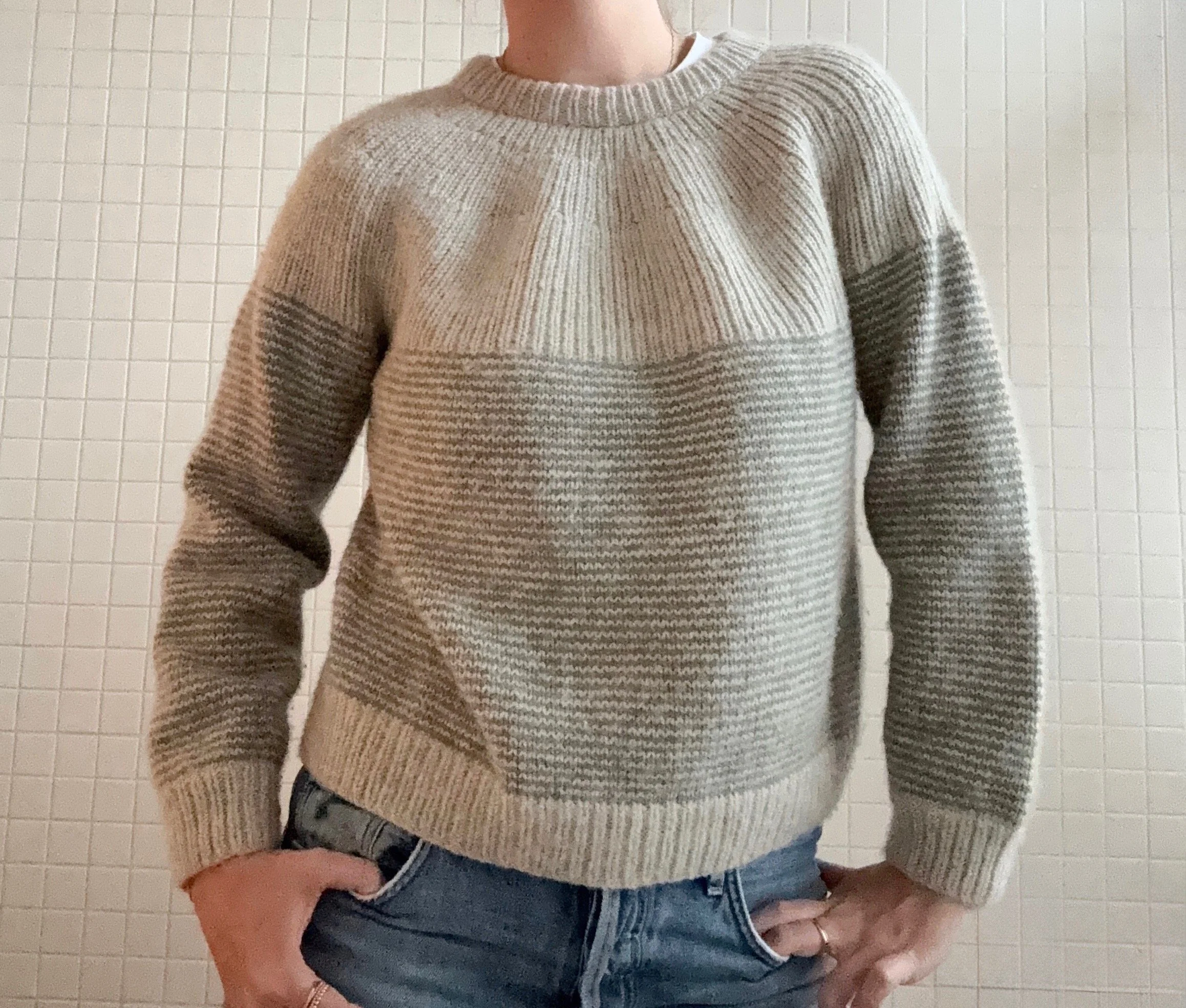Goodbye on Her Terms
The sweater my mother knitted her love into on one of her last days.
Medical assistance in dying (MAID) is a process that allows someone who meets the eligibility criteria to receive assistance from a medical practitioner in ending their life. It’s both simple and complicated. From a distance, it can seem like a dignified and peaceful option—unless, of course, personal or religious beliefs complicate the matter. But who wouldn’t want a loved one to die with dignity, without pain, and surrounded by those they love?
I want to share my experience of going through this process with my mother (there is a knitting connection if you read far enough along). I’m often asked about it, and I find that people are left wanting to understand more. There’s a sense of awe in the journey, a curiosity about what it’s really like.
My Mother
My mother was 88 years old, with the sharpness, wit, and curiosity of someone half her age. She sent emoji reactions in her texts, bantered about sports with my grown children, discussed finances with my husband, and was a daily source of back-and-forth with me. She was a contradiction: outwardly strong, a rock for others, but inwardly insecure and easily embarrassed. She would prop up those around her yet shy away from her own struggles.
Though I’m in my fifties, she wouldn’t sleep until she knew I was home safely. She couldn’t bear bad news from her children and often avoided hard conversations because they caused her too much worry. Yet, she was bold enough to argue politics in a room full of opposing beliefs and wasn’t afraid to question modern trends, technology, or “wokeness.” She managed her finances daily, played a mean game of bridge, and remembered everything people told her. If you mentioned something one day, she’d follow up the next. She was reflective—if you called her out on an outdated belief, she’d push back at first but later consider how to see things differently. She was direct but never insensitive.
If you know me at all, you know my mother—though I like to think I’m the new and improved version.
The Beginning of the End
Her health was generally okay for her age, but mobility was an issue. A sharp mind, but unstable legs. It all began when she had a fall that landed her in the hospital with a broken arm. Since she relied heavily on her arms to get out of chairs and bed, this was a major setback. She needed a walker, a cane, and special toileting accommodations. My saintly brother stayed with her for a while, and then I traveled across the country to do my share of live-in care. She had assistance from care aides, but only at wake-up and bedtime. I filled in the gaps.
What was supposed to be a week or so of slow improvement turned into a rapid decline. Instead of recovering, she grew weaker, lost her appetite, and became depressed. She was miserable. She had always dreaded the indignity of dying, and this situation only confirmed her fears.
“What am I doing all this for?” she asked repeatedly.
Eventually, I could no longer lift her on my own. After a terrible attempt to transfer her from her bed to a commode, she lost the strength in her legs, seemed faint, and it was time to call an ambulance. It broke her heart, but for me, it was a relief—I was exhausted.
One thing about my mother: she was neither affluent nor flashy, but presentation mattered. Even as the paramedics were on their way, she insisted on getting dressed. And—dammit—she needed her lipstick! I loved this small act of humor and self-respect. When they arrived, she greeted them with her usual warmth, wit , and dare I say flirtation? before heading off to get some well-deserved medical attention.
Hospital Stay and a Life-Altering Decision
My brother and I met her at the hospital, where she lay gowned and rigged up to everything. We soon learned that she had contracted COVID-19 during her previous hospital stay, and it had drained her. Among other worrisome vitals, her blood pressure was dangerously low. The doctors suggested an aggressive treatment that might stabilize her but could also risk her heart.
Without hesitation, she said, “Go for it.”
Then, with equal certainty, she asked me and my brother, “Do you have my DNR?” It was time to call our Kamloops sister and get her to Comox
She knew what she wanted. Our father had died a few years earlier, her affairs were in order, and in her eyes, she had lived a long, full, and beautiful life.
Ironically, she stabilized on her own before receiving the treatment. A less risky alternative was prescribed, and she was moved to a hospital room to recover. But she didn’t. Though not in critical condition, her strength continued to fade, her appetite dwindled, and she could no longer get out of bed on her own. Her mood darkened.
“What am I doing all this for?”
Then, in a moment of pure empathy, unconditional love, and bravery, I asked her:
“Do you want to talk about MAID?”
“Yes, I do.”
She had known others who had chosen this path and admired how peaceful their experiences had been—filled with calm, togetherness, and closure. We left it at that. We watched curling, Jeopardy, and home renovation shows. We talked about love, romance, finances, and politics. I even had her knit a few stitches into a sweater I was making.
Some of our conversations in those days were the most open and honest we had ever shared. I cried. I told her I was scared. And the love I felt from her, as the baby of the family, was just as strong as when I was a child.
The Process of Saying Goodbye
The practical side of this process involves a few hoops, though it moves surprisingly quickly—only about two weeks from start to finish. To begin, you must meet the criteria, have your doctor’s support, and then undergo a 90-minute interview with a provincial doctor. This is where the assessment takes place, to determine if this decision is justifiable. According to my mom, the doctor knew within minutes that she was of sound mind and ready. Upon eventual approval, we waited for a date.
Once she made her decision, I wasn’t afraid to talk about it with her. I felt I owed her that. She had just made one of the biggest, most shocking choices of her life—it didn’t seem right to sweep it under the rug.
One of the most memorable moments came when she paused and asked me:
“Do you think I’m doing the right thing?”
The silence that followed felt like hours. I knew this wasn’t my decision. The staff, pamphlets, and doctors constantly reminded us that MAID is the patient’s choice alone. So I chose my words carefully. I told her that I supported her.
A few minutes later, I asked if she had been looking for my approval.
“No,” she said calmly. “I was just curious.”
Those last days were both leisurely and intentional. We talked shop, spoke about family, bemoaned world issues, and gossiped about celebrities. As the out-of-town child, I had nowhere else to be all day but with her, but she was showered with frequent and heartfelt visits by her other children and their families. She made phone calls to friends, explained what was happening, and said her goodbyes. Her grandchildren FaceTimed her, sharing love and gratitude. What a luxury—to be of sound mind, to plan ahead, to say the things you truly want to say.
The Final Day
The appointment was set for 3 PM. That morning, I woke up alone in my mother’s apartment, the sun shining. At a coffee shop, when asked, “How’s your day going?” I hesitated. How do you even answer that?
When we arrived at the hospital, she was her usual self—chatting, rolling her eyes at the waiting. We offered her a special lunch, but she wasn’t interested. She laughed at the idea of putting on a fancy outfit. The only thing she insisted on was her dentures, lipstick, and no rogue chin hairs.
At 3 PM, surrounded by her children, closest friends, and longtime GP, the doctor asked her one last time:
“Shirley, do you want me to proceed with the injection that will stop your heart and allow you to die?”
She looked him in the eye, and I had never seen her so certain.
“Yes.”
The first injection put her to sleep. The second and third stopped her heart. Moments later, the doctor listened with his stethoscope, closed his eyes, and then nodded.
She was gone.
Aftermath
Days later, weeks later, even now, I ask myself: Did she make the right choice? How did she know? Should I have questioned her more?
One of my kids was initially angry. Another wouldn’t talk about it. A third understood.
Letting someone you love choose to die is both deeply empowering and incredibly heavy. It’s an act of love that requires a strength I didn’t know I had, a balance between unwavering support and silent second-guessing. I’ve replayed many of the conversations and moments of silence during those few weeks—wondering if I should have asked more questions, suggested alternatives, or pushed back a little. But then I remember how certain she was, how ready she seemed, and how she expected us to stand by her.
In the end, maybe this wasn’t a decision she made alone. Perhaps it was the culmination of a lifetime of love, honesty, and the way we navigated life together as a family. Her strength in living on her own terms didn’t come from isolation, but from the deep connection we shared and the confidence we inspired in her. It wasn’t about leaving alone—it was about choosing to leave with the freedom and peace that her relationships gave her. She left, in the end, just as she lived—a goodbye on her terms.

